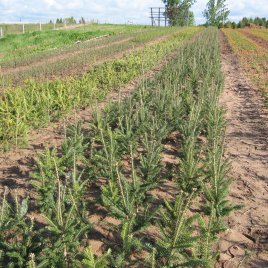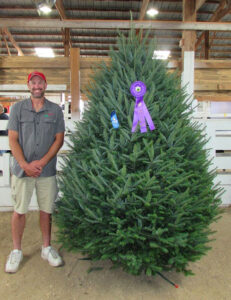
Is a Christmas Tree Farm Right for Your Land?
This could be the perfect time to start growing Christmas trees — whether you are only interested in a few for your own friends and family or whether you want to start a lucrative business on some extra acres — according to Greg Hann, member and promotions director of the Wisconsin Christmas Tree Producers Association (WCTPA).
Most Christmas tree farms in Wisconsin have been established for some time. “Out of the 160 members, less than 10 are new in the industry,” says Hann. “But it’s exciting to watch our organization start to flip to a newer generation. There’s a real opportunity right now because the millennial generation is influencing so many industries. We are happy to see the small mom-and-pop choose-and-cuts are not all being closed. They are being sold to a younger generation.”
“It’s hard to start a Christmas tree farm from scratch because of the long wait, but if you have some land that would work, and some patience, there are possibilities. It’s a pretty small investment for the return.” Hann says.
Here are some suggestion for getting started:
1. First Test Your Soil

Scotch and White Pine used to be popular for Christmas trees here, but in Wisconsin today, buyers prefer the Fraser Fir. This tree is extremely sensitive to soil pH. and will not grow satisfactorily on sites where pH levels exceed 6.2. Hann recommends a pH of 5 to 5.5. “The nice part is that, while this low pH soil that may not be so good for many cash crops — it is perfect for the Balsam and Fraser we grow here for Christmas trees in Wisconsin.”
“You do not want a low-lying area,” Hann emphasizes. “Frasers get phytophthora root rot.” , They do better in higher spots with good drainage where the ground is rocky or not very tillable.
2. You May Need Irrigation
Fraser Firs are not native to Wisconsin. “Some years, you won’t need to irrigate,” Hann says, “but some you will. If you get into serious Christmas tree farming of 10,000 trees or more, irrigation would be beneficial for dry years.”
3. Determine How Much Land You Will Plant

Fraser Firs grow four to six inches a year for the first several years till they have a root base. “After that, you get a foot a year — and that is where we get our calculation of eight to 10 years to produce a seven to nine-foot tree.”
Christmas trees are planted 1,000 to 1,200 per acre. “You can calculate the amount of land to use based on how many trees you want to harvest annually,” says Hann. “With five acres, you can plant around 5,000 trees. Divide that by 10, which gives you 500 a year.” The same calculation can work for a few trees to supply friends and family or a much larger operation. Hann cuts about 6,500 trees a year on his farm near Oregon, WI.
“Christmas trees take long-term planning, but don’t need the maintenance that other crops do,” says Hann. “Many Christmas tree growers with 10 acres of trees can do it as part-time job, but if you have more than 40 acres, it is definitely a full time job.”
4. Christmas Tree Maintenance
For someone doing a small, personal planting, Hann recommends picking up some evergreens at a big box store. He suggests planting balsam fir, which is native to Wisconsin and does not have the pH requirements of Fraser Firs.
For larger quantities, Hann suggests checking the WCTPA website. “Look for a nursery in your area that is acclimatized to the zone you are growing in,” he advises. “Local trees handle the first summer so much better. You will have less die out. We interplant every year. If one dies, we plant another in its place.”
When starting, you can rent a planter or find someone to plant your Christmas trees, which you will put in the ground as three-year-old plants. “They have grown one year in a nursery, and two years outside before you get them,” says Hann. “After they are planted in your ground, you need to keep the weeds down so the trees can get the water they need and establish roots. Some people use backpack sprayers. Some use a sprayer on an ATV. It is also good to mow between the rows.”
As the trees get bigger, they require fertilizing and irrigation. After the first three years on your land, you need to shape the tree. “Shearing gives the tree the more dense branching that people want in their Christmas tree,” says Hann. It also makes the shape narrower and easier to bring into the house.
Shearing can be done by the land owner with a long shearing blade that resembles a three-fool-long serrated bread knife. “Some growers use two knives — one in each hand, or they may have a clipper in the other hand,” Hann says. There are many videos on line that demonstrate how to shear, and the University of Wisconsin has detailed instructions on shearing.
Hann also noted that there are several professional shearing companies that can come to your farm. “The one I use brings 14 to18 people, and they shear my fields in a day and a half.” You can find out more about these companies at the WCTPA website.
5. Potential Profits

For Hann, Christmas trees are a full-time job. “We are the Hallmark movie of tree farms. We have Santa and Mrs. Claus, hot cider, wagon rides, wreaths, ornaments and tree lights, wagon rides, and a playground for kids. It makes the customer happier to have everything they want at their fingertips, and the millennial generation likes to do day trips.
If that type of merchandising seems like too much, you can also find businesses looking to buy bulk-cut trees through the WCTPA .
Hann doesn’t recommend buying 40 acres and starting a Christmas tree farm because it requires 10 years for the first harvest. “But it is something you can do with a part of your land that you can’t get big equipment into. There are tax incentives as well. I’m not an accountant, but I know I only play 15% capital gains when I harvest.”
“Three-year-old trees cost about $1.25,” Hann adds. “Everyone’s maintenance costs are a little different, but from a smaller, 7 acre planting, in 10 years you could be selling 700 trees a year, and right now a tree is going for at least $60. That’s pretty good for a part-time job you can do in your free time.”




